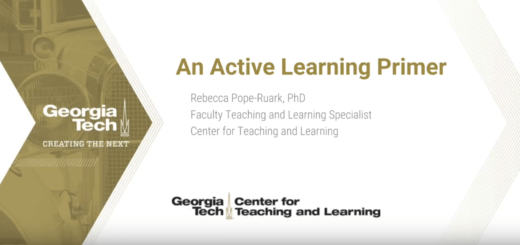Using Technologies to Facilitate Collaborative Learning

Collaborative learning involves groups of students working together toward a common learning goal: to solve a problem, complete a task, or create a product (MacGregor, 1990). It has been widely researched and many have found it to be beneficial in helping students learn effectively and efficiently: students are able to learn and retain more information by engaging with one another and develop a more positive attitude about learning and each other by working together (Lou, et al., 1996; Johnson & Johnson, 1989; Pantiz, 1999; Springer et al., 1999).
Technology plays an important role in collaborative learning. Many technologies have enabled learners to communicate and collaborate even though they are geographically dispersed. These technologies are used in face-to-face, blended, and online learning environments. Here are a few technologies you may leverage to facilitate collaborative learning in your classes for the coming new semester:
- CATME: CATME stands for Comprehensive Assessment of Team Member Effectiveness. It is an online platform that helps instructors to effectively organize student teams, manage students’ team experience, and facilitate peer evaluation. Georgia Tech has a site license with CATME and instructors can use it free by creating an instructor account at the CATME web site with their Georgia Tech email.
- Canvas Group Workspace: Georgia Tech has a new learning management system, Canvas, and all courses are available in Canvas starting from Spring 2018. If you are stilling thinking whether you should use Canvas or T-Square, no doubt you should go with Canvas if you want to integrate collaborative learning activities. You can create groups for students or allow students to create their own groups in Canvas. Each group will have their own workspace, which is like a small version of a course. Students can share files, collaborate on wiki pages, and interact with group members through online discussions and web conferences. Students can literally do all their group work within Canvas. They
 do not need to log on to Google Hangout, Slack, or whatever groupware they used before for collaboration.
do not need to log on to Google Hangout, Slack, or whatever groupware they used before for collaboration. - Piazza in Canvas: Piazza has been used in many classes at Georgia Tech. It is an online discussion forum and a Q&A platform. It also has a polling tool that some instructors use for question polling in class and outside of class. Piazza is integrated with both T-Square and Canvas, which means you and your students do not need to create a separate account in order to use it. If you have been using it in T-Square, you may continue using it in Canvas. It is a default tool in Canvas. According to the results of a survey conducted by CTL in 2016 among 554 students at Georgia Tech, 72% of the respondents said the online discussions on Piazza were valuable in helping them learn. The respondents also said these are the top five things that an instructor could do to make online discussions effective: 1) post question prompts for discussions; 2) acknowledge the use of online discussions in class; 3) bring online discussions to the classroom; 4) provide incentives to encourage participation; and 5) participate more. If you are new to Piazza, try these things when you use it. They are easy to implement. If you have used Piazza and want to encourage more students to participate, try them as well.
- Microsoft Collaborative Whiteboard: Microsoft just rolled out the Microsoft Whiteboard Preview app on Dec. 5, 2017. It is a freeform digital canvas where users can share ideas and create content together both in person and remotely, and across multiple devices. It is good for collaboration that involves more than writing and typing. You can draw freely, whether it is a formula, a diagram, a picture, etc..You can download it for free from the Window Store on any Windows 10 or Windows 10s device. While Microsoft Whiteboard is in Preview mode, it is automatically disabled for organizations who use Office 365. Before the IT administrator for Office 365 at Georgia Tech enables it, you may use your own Hotmail or Outlook account to log on and use it. Microsoft is planning to take the app out of the Preview in a few months and then it will be turned on by default for organizations.
- Air Media: Air Media is a software program that allows students to present and collaborate by sharing their device screen on monitors in a classroom through wireless connection. No software installation is required. Students just need to use their web browser and follow the simple instructions on the monitors. It supports 32 devices connecting at a time. Instructors can easily control the room by selecting whose content to share. Air Media is installed in three renovated classrooms in Instructional Center, 105, 115, and 205, and possibly other classrooms as well. There are 6 TV monitors spreading across the classrooms. The furniture is movable. You may group your students and have them work together in front of a monitor. They don’t have to look at one small laptop screen. Instead, they can display their device screen on the monitor so that all group members can easily see it. You may also display their work to the entire class for discussions by just pressing a button. If you are interested in using Air Media but you are assigned to a classroom where it is not available, please contact OIT Classroom Technology to see if they can assist you in getting it installed.
These five technologies mentioned above are available and free to Georgia Tech faculty. If you want to try them in your classes and would like to learn more about the details, please feel free to contact CTL. We are happy to discuss with you, and experiment the technologies with you, if needed. If you have successfully used other technologies for collaborative learning, please share your experience in the comment section of this post.
References
Johnson, D.W. & Johnson, R.T. (1989). Cooperation and Competition Theory and Research. Edina, Minnesota; USA. Interaction Book Co. Publishing.
Lou, Y., Abrami, P. C., Spence, J. C., Poulsen, C., Chambers, B., & d’Apollonia, S. (1996). Within-class grouping: A meta-analysis. Review of educational research, 66 (4), 423-458.
MacGregor, J.T. (1990). Collaborative learning: Shared inquiry as a process of reform. In Svinicki, M.D. (Ed.), The changing face of college teaching, New Directions for Teaching and Learning, No. 42. San Francisco; USA, Jossey-Bass Publishing.
Springer, L., Stanne, M. E., & Donovan, S. S. (1999). Effects of small-group learning on undergraduates in science, mathematics, engineering, and technology: A meta-analysis. Review of educational research, 69(1), 21-51.




